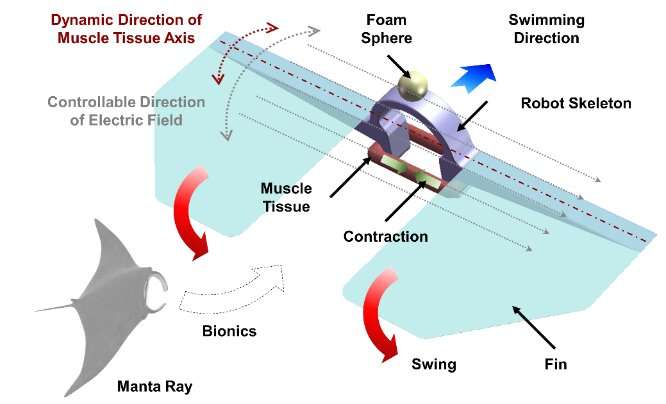This bio-syncretic swimmer was composed of a skeleton structure, two fins, a living actuator, and a foam balance microsphere. Credit: Chuang Zhang, Shenyang Institute of Automation, Chinese Academy of Sciences
Nature has provided great support for the development of robots. Inspired by manta rays, a team from the State Key Laboratory of Robotics at the Shenyang Institute of Automation, Chinese Academy of Sciences, has developed a bionic swimming robot that is actuated by cultured skeletal muscle tissue and controlled by circular distributed multiple electrodes (CDME). The robot can be efficiently propelled by only one muscle tissue.
Biomimetics is one of the most important robotic research methods, which can improve the kinematic performance of robots by imitating the structure and behavior of natural organisms. The bio-syncretic robot, which uses natural biological materials as the core element, is the further development of bionics.
Some living cells have been used to realize some functions of robots, including sensing, control, and actuation. However, innovative propulsion and control methods are needed to further develop the controllable motion performance of bio-syncretic robots. To solve this problem, researchers proposed a dynamic control method based on CDME. The research was published in the journal Cyborg and Bionic Systems.
The team found that the electric field generated by CDME was less harmful to the culture medium and cells than conventional electrodes. Using this method, the direction of the electric field generated by the electrode could be dynamically controlled, keeping it parallel to the driving tissue of the robot in real-time, thus ensuring stable control of the robot.
First, the team designed the robot skeleton based on the manta ray's structure and used polydimethylsiloxane (PDMS) as the main material for the structure. At the same time, to facilitate the assembly of the driving tissue and the robot structure, the researchers chose the ring-shaped tissue made by myoblasts as the drive unit of the robot.
In addition, to obtain circular muscle tissues with effective contractility, a rotational electric stimulation from the CDME was used to realize uniform induction of the myoblasts to differentiate into myotubes. To allow the robot to swim at a desired speed, the contractility of the muscle tissue was measured before assembly with the swimmer structure. The research team also used simulation methods to analyze the relationship between the robot's motion performance and the driving tissue contraction force.
Finally, to demonstrate the stable and controllable motion of the proposed bio-syncretic robot, the researchers realized the controllable swimming of the robot at different speeds using the proposed dynamic electrical stimulation method. In the experiment, the robot demonstrated effective swimming and stable controllability, which verified the effectiveness of the biomimetic design and CDME-based control method proposed by the research team.
The biomimetic design and actuation control method proposed in this study not only promote the further development of bio-syncretic robots but also have certain guiding significance for the biomimetic design of soft robots, muscle tissue engineering, and other related fields.
However, although the current bio-syncretic robots have achieved effective controlled motion, there are still many key bottlenecks that need to be overcome. For example, most of the robots are centimeters in size, which is difficult for applications such as drug delivery in vivo.
Technologies including 3D printing and flexible manipulation oriented to micro-nano biological structures are key to developing bio-syncretic micro-robots for clinical applications and other special environments. In addition, most of the existing bio-syncretic robots rely on external artificial stimuli to achieve controlled movement, which may lack autonomy. Therefore, the sensing and control method based on living cells may be applied to the research of bio-syncretic robots in order to realize autonomous robot movement based on environmental information.
More information: Chuang Zhang et al, A Manta Ray-Inspired Biosyncretic Robot with Stable Controllability by Dynamic Electric Stimulation, Cyborg and Bionic Systems (2022). DOI: 10.34133/2022/9891380
Provided by Beijing Institute of Technology Press
























